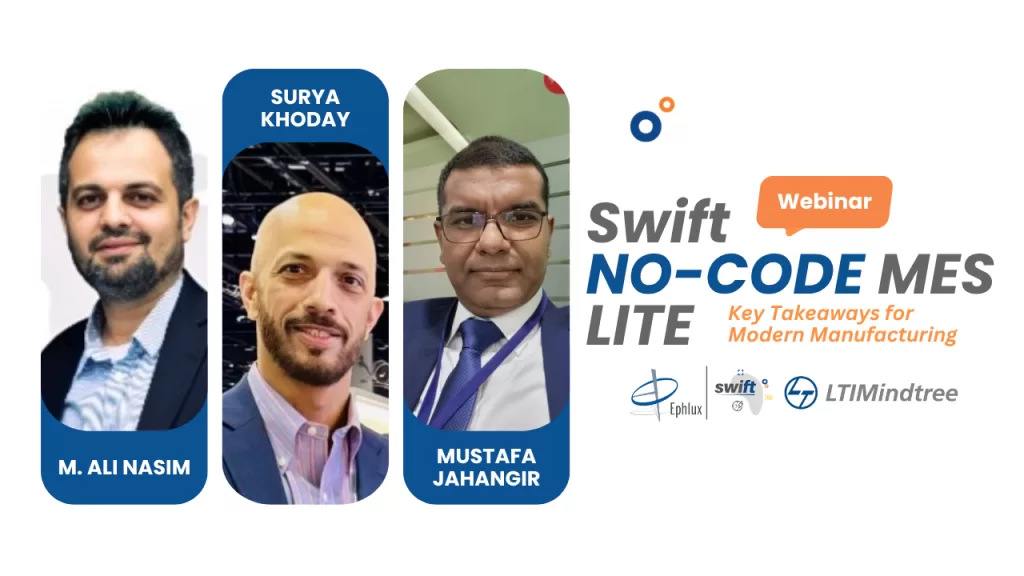Swift no-code MES Lite Webinar Key Takeaways for Modern Manufacturing
MES Without the Mess: Keeping SAP Clean and Agile
At a recent Ephlux & LTI Mindtree webinar, experts Ali Nasim, Surya Khoday, and Mustafa Jahangir introduced Swift MES Lite—a no-code MES solution built for SAP S/4HANA.
Why It Matters:
- Solves integration headaches (bye-bye, technical debt!)
- Boosts agility with no-code + AI
- Simplifies adoption for manufacturers
Watch the highlights below to see how it’s transforming production floors—without the coding chaos.

- The Challenges of MES Integration with SAP S/4HANA
- The Manufacturing Process: From Planning to Execution
- The Hidden Cost of Technical Debt
- Prioritizing the Shop Floor User Experience
- Introducing Swift MES Lite: A No-Code AI Revolution
- Demo: Streamlining Production Order Confirmations
- The Power of No-Code with Swift Designer
- AI-Driven Innovation with Swift AI Designer
- Key Takeaways and Next Steps
- Related Post
The Challenges of MES Integration with SAP S/4HANA
Manufacturers using SAP S/4HANA struggle with third-party MES integrations—dealing with complexity, IT bottlenecks, slow data access, and rising costs. As Surya outlines the complexities of integrating MES solutions with SAP S/4HANA, emphasizing the dependency on IT, latency in data, and the high cost of maintaining fragmented systems.
“Because of the complexity of the integration of third-party MES solutions with SAP S/4HANA, there is a need for making that easy from a user perspective.” — Surya Khoday
This clip sets the stage by addressing a universal pain point: the technical debt that accumulates when manufacturers rely on custom code and disjointed systems. This debt not only increases costs but also limits the ability to adapt to changing market demands.
The Manufacturing Process: From Planning to Execution
The manufacturing process is a complex, multi-stage journey that requires precise coordination to deliver products efficiently. As Mustafa Jahangir highlighted in the webinar, it begins with integrated business planning, where organizations forecast demand for the upcoming quarter or fiscal year.
This planning phase involves:
Material Requirements Planning (MRP) to secure raw materials in advance
Production Execution, where materials are issued, moved to the facility, and transformed into finished goods
Real-time tracking, rule validation, and equipment monitoring to ensure quality and performance
However, many manufacturers struggle due to outdated or poorly integrated MES systems, causing delays, anomalies, and lack of visibility between the shop floor and leadership—ultimately impacting customer satisfaction. In the clip below, Mustafa explains why seamless integration is critical to solving these pain points.
“There is definitely a risk of anomalies and delays… the top floor management completely becomes unaware of what is happening on the shop floor.” — Mustafa Jahangir
This clip underscores the need for a solution that bridges the gap between planning and execution, providing real-time visibility and simplifying operator tasks to ensure the manufacturing process runs smoothly.
The Hidden Cost of Technical Debt
Technical debt is more than a buzzword—it’s a barrier to innovation. In the following clip, Surya discussed how traditional MES integrations lead to a tangle of custom solutions that require continuous maintenance, locking manufacturers into rigid, costly systems.
“You’re creating technical debt that can keep stifling your agility moving forward.” — M. Ali Nasim
This discussion underscores the need for a modern approach that minimizes custom development and empowers businesses to iterate quickly without accumulating technical baggage.
Prioritizing the Shop Floor User Experience
At the heart of manufacturing execution is the shop floor operator, whose productivity depends on simple, intuitive tools. Surya shared a compelling case study of a global manufacturer struggling to provide shop floor users with easy access to production confirmations, revealing the gap in traditional MES solutions.
“If there was an easy way to do that with one click or one view, the shop floor people would be a lot happier and a lot more productive.” — Surya Khoday
This clip resonates with manufacturers who want to empower their operators with tools that reduce complexity and enhance efficiency, setting the stage for Swift MES Lite’s user-friendly approach.
Introducing Swift MES Lite: A No-Code Revolution
Swift MES Lite, a no-code MES solution designed to simplify manufacturing execution while leveraging SAP S/4HANA’s robust capabilities. In the clip below, Ali and Mustafa introduced Swift MES Lite, showcasing its unified user experience, seamless integration, and real-time data updates without creating data silos.
“The data should stay where it belongs. The system of truth should stay your ERP.” — M. Ali Nasim
Unlike traditional MES solutions that require extensive coding, Swift MES Lite builds on existing SAP investments, ensuring data integrity and eliminating the need to reinvent the wheel. This clip highlights the solution’s ability to deliver immediate value to shop floor operators and top-floor management alike.
Demo: Streamlining Production Order Confirmations
To illustrate Swift MES Lite’s impact on the manufacturing process, Ali Nasim walked through a demo showing how a production line operator can confirm production orders with a simplified interface. The system pulls real-time data from SAP S/4HANA, ensuring accuracy and efficiency in production execution.
“All the values that you see are getting pulled in from SAP S/4HANA… we’re not writing any logic to pull that up.” — M. Ali Nasim
This demo showcases how Swift MES Lite simplifies a key step in the manufacturing process, enabling operators to focus on production rather than navigating complex screens, ultimately improving throughput and reducing errors.
The Power of No-Code with Swift MES Designer
Swift MES Lite’s no-code platform, the Swift Designer, empowers business users to create custom dashboards and forms tailored to the manufacturing process without coding expertise. In this clip, Ali Nasim demonstrated how users can drag and drop widgets to build intuitive interfaces, pulling metadata directly from SAP S/4HANA.
“You see different applications here, different users you’ve activated… It’s built very, very simply by dragging, dropping these widgets.” — M. Ali Nasim
This clip highlights how shop floor teams can take more control—like checking material availability or monitoring production, without needing to rely so much on IT. It’s about making daily tasks more manageable and efficient.
AI-Driven Innovation with Swift AI Designer
The webinar also explored the future of manufacturing with AI.
Ali Nasim demonstrated the Swift AI Designer, a conversational tool that generates MES objects like production orders and bill of materials, seamlessly integrating them with SAP S/4HANA to address gaps in the manufacturing process.
“Imagine building an MES solution through a conversation… This is the future of app development!” — M. Ali Nasim
This forward-looking clip showcases how AI can accelerate the development of tools for production planning and execution, making it a must-see for manufacturers eager to stay ahead in a competitive landscape.
Key Takeaways and Next Steps
The webinar delivered a clear message: manufacturers can overcome the challenges of MES integration, technical debt, and user adoption with Swift MES Lite, transforming the manufacturing process from planning to execution.
Here are the key takeaways
- Empowered Business Teams: No-code platforms enable shop floor teams to customize tools, reducing IT dependency.
- Operational Flexibility: Rapid iteration and real-time feedback ensure solutions evolve with production needs.
- Reduced Technical Debt: Leveraging SAP S/4HANA’s logic minimizes maintenance burdens.
- AI-Driven Agility: Conversational AI accelerates the development of manufacturing tools.
- End-to-End Visibility: Real-time insights from shop floor to top floor enhance decision-making.
As Surya aptly summarized, “Showing is better than talking.”
The Swift MES Lite helps you get more out of SAP S/4HANA fast—no long waits, no big spend—just a straightforward way to make your manufacturing run smoother.

For JD Edwards Users




